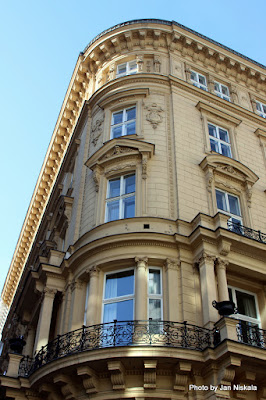Melk
Austria and Schonbrunn Palace Vienna
We
have now sailed the Danube to Melk Austria.
The town of Melk sits at the point where the River Danube enters the Wachau Valley. Melk is best known for its massive
Benedictine Abbey, one of the most splendid monastic houses in Austria. Previously the Abbey of today was a palace
built to defend the border. In the eleventh century Leopold III handed his
palace over to the Benedictine monks. The original abbey had been damaged
several times by fire; the present magnificent Baroque structure was built
between 1702 and 1738. The Abby Interior
highlights include the Imperial Staircase, the 196-meter-long Imperial
Corridor, the exquisite Grand Marble Hall, with its fine ceiling paintings
showing mythological scenes extolling the virtues of the ruling house of
Austria, and the library with beautiful ceiling paintings and more than 90,000
volumes and rare manuscripts. The Abbey Church is considered the finest Baroque
church north of the Alps. We were not able to tour the inside of the Abby so
interior photos now marked with my name, the others are graciously offered as ‘free to
share and use’ by some of my Flickr friends.




Melk remains a delightful place to explore, particularly its old town
center, which has preserved many of its original historic buildings.
As
we cruised down the Danube we saw tons of little towns and villages and it
seemed like they all had castles, palaces and lovely churches. Here are some of the scenes we enjoyed.
Vienna is known as a cultural capitol boasting wonderful music, exquisite architecture, and delicious pastries. We attended a Viennese concert featuring works by Mozart and Strauss. Needless to say, it was awesome!! But here are some photos of sites in Vienna.





Two additional highlights for us were St. Stephen’s Cathedral and Schonbrunn Palace.
First, St. Stephen’s Cathedral; According to our guide St. Stephen's Cathedral is the mother church of the Roman Catholic Archdiocese of Vienna and the seat of the Archbishop of Vienna. The current Romanesque and Gothic form of the cathedral seen today was largely initiated by Duke Rudolf IV (1339–1365) and stands on the ruins of two earlier churches, the first a parish church consecrated in 1147. The most important religious building in Vienna, St. Stephen's Cathedral has borne witness too many important events in Hapsburg and Austrian history and has, with its multi-colored tile roof, become one of the city's most recognizable symbols.
The next Schonbrunn Palace; Schonbrunn Palace was the main summer residence of the Hapsburg rulers, located in
Hietzing, Vienna. The 1,441-room Rococo palace is one of the most important architectural,
cultural, and historic monuments in the country. Since the mid-1950s it has
been a major tourist attraction. The history of the palace and its vast gardens
spans over 300 years, reflecting the changing tastes, interests, and
aspirations of successive Hapsburg monarchs. Not
surprising there were no photos allowed inside but they had lovely photos of
the interior on the various video monitors and/or posters, so I took photos of
their photos to share with you!



One interesting and beautiful person of interest was Sisi, Empress of Bavaria. Elisabeth of Bavaria was Empress of Austria and Queen of Hungary by marriage to Emperor Franz Joseph I. Elisabeth was born into the royal Bavaria house of Wittelsbach. Nicknamed "Sisi", she enjoyed an informal upbringing before marrying Emperor Franz Joseph I at the age of sixteen. The marriage thrust her into the much more formal Hapsburg court life, for which she was unprepared and which she found uncongenial. Early in the marriage she was at odds with her mother-in-law, Archduchess Sophie, who took over the rearing of Elisabeth's daughters, one of whom, Sophie, died in infancy. The birth of the heir apparent, Crown Prince Rudolf, improved her standing at court, but her health suffered under the strain, and she would often visit Hungary for its more relaxed environment. She came to develop a deep kinship with Hungary, and helped to bring about the dual monarchy of Austria–Hungary in 1867.
Vienna is known as a cultural capitol boasting wonderful music, exquisite architecture, and delicious pastries. We attended a Viennese concert featuring works by Mozart and Strauss. Needless to say, it was awesome!! But here are some photos of sites in Vienna.





Two additional highlights for us were St. Stephen’s Cathedral and Schonbrunn Palace.
First, St. Stephen’s Cathedral; According to our guide St. Stephen's Cathedral is the mother church of the Roman Catholic Archdiocese of Vienna and the seat of the Archbishop of Vienna. The current Romanesque and Gothic form of the cathedral seen today was largely initiated by Duke Rudolf IV (1339–1365) and stands on the ruins of two earlier churches, the first a parish church consecrated in 1147. The most important religious building in Vienna, St. Stephen's Cathedral has borne witness too many important events in Hapsburg and Austrian history and has, with its multi-colored tile roof, become one of the city's most recognizable symbols.



One interesting and beautiful person of interest was Sisi, Empress of Bavaria. Elisabeth of Bavaria was Empress of Austria and Queen of Hungary by marriage to Emperor Franz Joseph I. Elisabeth was born into the royal Bavaria house of Wittelsbach. Nicknamed "Sisi", she enjoyed an informal upbringing before marrying Emperor Franz Joseph I at the age of sixteen. The marriage thrust her into the much more formal Hapsburg court life, for which she was unprepared and which she found uncongenial. Early in the marriage she was at odds with her mother-in-law, Archduchess Sophie, who took over the rearing of Elisabeth's daughters, one of whom, Sophie, died in infancy. The birth of the heir apparent, Crown Prince Rudolf, improved her standing at court, but her health suffered under the strain, and she would often visit Hungary for its more relaxed environment. She came to develop a deep kinship with Hungary, and helped to bring about the dual monarchy of Austria–Hungary in 1867.
More
coming soon 😊
Jan 🌷🌷🐾🐾
















































































































































